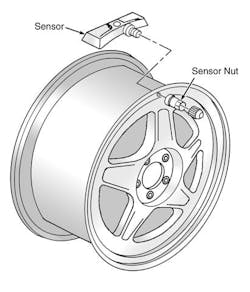Blazing a new Trail (carefully)
SUBJECT VEHICLE: 2006-08 TrailBlazer.
SENSOR IN TIRE? Yes.
RESET PROCEDURE? Yes.
SPECIAL TOOLS NEEDED? Optional (TPM Sensor Activation Tool J-46079).
The 2006-08 Chevrolet TrailBlazer’s tire pressure monitoring system (TPMS) displays individual tire pressure data and tire locations on its Driver Information Center (DIC) device. The TPMS uses a variety of components: the Powertrain Control Module (PCM), the Body Control Module (BCM), the Instrument Panel Cluster (IPC), the DIC, the Endgate Module (EGM), and others. The EGM is on models with the power sliding rear roof. On other models, the EGM is replaced by the Liftgate Module (LGM).
When the vehicle is standing still, the sensors go into stationary mode. In this mode, the sensors transmit once every 60 minutes to cut down on battery use. As the vehicle’s speed increases, the sensors go into drive mode. In this mode, they transmit once every 60 seconds.
When tire pressure drops, a “CHECK TIRE PRESSURE MESSAGE” shows up on the DIC and the low pressure indicator on the IPC illuminates. Any malfunctions detected will cause the DIC to display a “SERVICE TIRE MONITOR” warning message.
Sensor swap
Before you can exchange tire pressure sensors, you must demount the tire from the wheel according to the tire changer manufacturers’ instructions. Once you’ve accomplished that, follow these steps:
1. Remove the tire pressure sensor nut ( Figure 1).
2. Remove the sensor from the wheel hole.
3. Remove the sensor grommet from the valve stem.
4. Clean any dirt or debris from the grommet sealing areas. Install the grommet on the sensor valve stem.
5. Insert the sensor in the wheel hole with the air passage facing away from the wheel.
6. Install the sensor nut. Position the sensor body parallel to the inside wheel surface while tightening the nut to 62 inch-pounds.
7. Before installing the tire on the wheel, note the following items to avoid sensor damage. Position the mounting/demounting head 180 degrees from the valve stem. Position the bead transition area 45 degrees counterclockwise of the valve stem. Using the tire machine, rotate the tire/wheel assembly clockwise when transferring the tire bead to the inside of the wheel rim.
8. Repeat the above items for the outer bead.
9. Install the tire on the wheel.
Note that tire pressure sensors are shipped in OFF mode. In this mode, the sensor’s identification code cannot be learned into EGM’s memory. The sensor must be taken out of OFF mode by spinning the tire/wheel assembly above 20 mph for at least 10 seconds in order to close the sensor’s internal roll switch. You’re now ready to retrain the pressure sensors.
Time to relearn
Whenever a wheel has been rotated, a sensor has been replaced or the EGM/LGM has been replaced, you must retrain the sensor.
Before proceeding with the following steps, make sure no other sensor learn procedure is being performed at the same time or that the tire pressures are not being adjusted on a TPMS-equipped vehicle within close proximity.
In the following procedure, a TPM Sensor Activation Tool (J-46079) may be used in place of increasing and/or decreasing pressures to enable the new sensors. To use this tool, place the activator antenna against the tire sidewall close to the wheel rim at the valve stem location, then press and release the ACTIVATE button. To relearn the sensor, follow these steps:
1. Turn the ignition to the ON position with the engine off. Apply the parking brake.
2. Turn the headlight switch from the OFF position to the parking lamps four times within four seconds. A double horn chirp will sound and the low pressure indicator will start to flash. This indicates that the learn mode has been enabled.
3. Starting with the left front tire, increase or decrease the pressure for eight to 10 seconds or until a horn chirp sounds. The chirp may occur before the eight to 10 seconds period has been reached or up to 30 seconds after this period has been reached.
4. After the chirp has sounded, proceed as in Step 3 for the next three sensors in the following order: right front, right rear and left rear. (Relearns must be performed in the proper order.)
5. After the left rear sensor has been relearned, turn the ignition switch to the OFF position to exit the learn mode.
6. Adjust all tire pressures to specification.
When moving through the relearn process, keep in mind that the TPMS will cancel the learn mode if more than two minutes have passed and no sensors have been learned or if the system has been in learn mode for more than five minutes.
If the learn mode is canceled before any sensor has been learned, the EGM/LGM will remember all current sensor IDs and locations. As soon as the first sensor ID code is learned, all other IDs are erased from the EGM/LGM’s memory.
On models that display tire pressures on the DIC, updated pressure levels will not be displayed until the EGM/LGM receives two more valid transmissions from each sensor. ■
Information for this column comes from Mitchell 1’s ”Tire Pressure Monitoring Systems Guide” for domestic and import vehicles through 2008. Headquartered in Poway, Calif., Mitchell 1 has provided quality repair information solutions to the automotive industry for more than 80 years. For more information, visit www.mitchell1.com.
